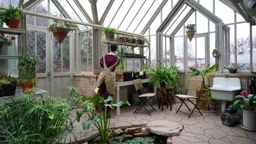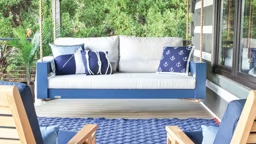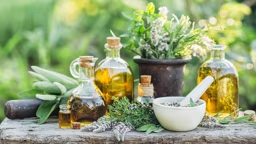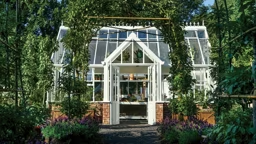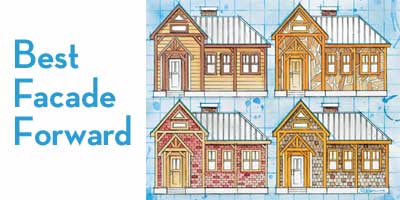
If windows are considered the "eyes of a house," then the facade is its face. The exterior materials chosen — like a lady's make-up or a gentleman's hairstyle — can add or detract from the look you want to achieve. You want your home to make a great first impression. Exterior building materials reinforce a home's architecture, giving the house a sense of time and place. They establish an overall atmosphere that can be either welcoming or imposing. But beyond appearance, the materials you choose perform a vital function: They shield your home from damaging sun, winter cold and destructive wind, rain and snow.
Explore Your Options
Historically, wood has been a popular choice for finishing the exterior of timber frame homes. But depending on the style and location of a house, various masonry materials, such as brick and stone, are equally appropriate, as is stucco. Some timber frame home owners even choose vinyl products, some of which remarkably resemble other natural materials. Before rushing into things, weigh your options wisely. Certainly, the style of your house counts. People expect to see beveled siding on a Colonial-style house, and by the same token, anything except clapboard on a Cape Cod-style house may be jarring. Regional building traditions are equally as important. In New England, that means siding and wooden shingles. When we think of the Southwest, stucco immediately comes to mind. Brick and other types of masonry are a building staple in many areas of the country, such as the upper South and the Midwest. But aside from tradition and aesthetic beauty, there are other reasons to choose one exterior facade over another. Climate is an important one. Stone stands up to the North's winter cold, whereas stucco helps keep rooms cooler by reflecting the harsh southwestern sun. Availability is another factor when weighing the pros and cons of exterior materials. Though it seems anything can be shipped anywhere these days, shipping costs can make a building budget balloon out of control. "Vermont is a natural place for a slate exterior because of all of our quarries," says Larry Kruse, vice president of North Woods Joinery in Jeffersonville, Vermont. "But in California, you would have to truck the material half-way across the country, which increases the cost." Another consideration is whether you can find the local expertise required to form those materials into an attractive facade. "You'd be hard-pressed to find someone who can work with stucco here in Vermont, simply because people don't use it," Larry says. In addition, home owners are faced with deciding how much time and effort they are willing to devote to exterior maintenance. Pristine facades don't just stay that way; they all require some degree of cleaning or touching up over time. But some need less than others. Stone may continue to look its best for many years with only an annual washing, explains Jim Nadeau of Classic Post & Beam in York, Maine. Wooden products, on the other hand, call for periodic re-painting or re-staining. Bearing all these factors in mind, let's take a closer look at the options.
Wood
Because it offers the advantages of a natural look and a variety of applications, wood cladding has long been a favorite exterior choice among timber frame home owners. Siding, often cedar, is one of the titans of wood cladding. Wood cladding is available in Grade A, or clear, form. Knotty boards are a popular option for those who want a more rustic exterior. Wood cladding is also versatile. It can be applied vertically, horizontally or in a board-and-batten style. While you're exploring the wood options, don't overlook the attractiveness of shingle and shake siding. Cedar, usually eastern white (also known as Atlantic white) or western red, is the overwhelming favorite in this category. Shingles, shakes and siding can be purchased pre-finished, which reduces home owner maintenance because the exterior paint or stain is applied and sealed during the manufacturing process. Most pre-stained products require a new application every five years, but some pre-finished painted siding only needs to be re-coated every 15 years. Check the manufacturers' warranties for precise instructions. In recent years, a subset of wood-siding materials called "wood-based" siding has been developed. These products look like the real thing but they are actually a combination of wood and manmade materials, such as cement. Their durability makes them an excellent choice for seaside houses subjected to harsh sun and salt spray. They are available in both siding and shingle form and can be ordered with a pre-finished coating.
Masonry
Masonry is probably the most durable of the exterior material options. This category ranges from brick to stone to a relatively new type of product called stone veneer ?all of which can be laid in a variety of patterns and colors that add visual texture to a house. The chief drawback to masonry is cost. It's one of the more expensive choices, but since it requires very little maintenance, the reduced cost and time required for upkeep might outweigh the cost of the material itself. In many regions of the country, a brick exterior is accepted as a sign of high-quality construction and status. It often is preferred over wood in the South because of its high resistance to insects, moisture and decay. Stone, considered by many to be one of the most beautiful building materials, reaches far back into recorded history. In Colonial times, it became a common building material in New England, because it was commonly found in fields and quarries. Before it could be cultivated, the notoriously rocky land of the North-east and Mid-Atlantic region had to be cleared by hand. The colonists made good use of the stone they dug up by fashioning it into houses, chimneys and low, property-defining walls. But because removing or quarrying stone is labor intensive, it can also be pricey. Artificial stone veneer bears the look of the real thing but is less expensive. It simulates the look of a wide range of natural materials, such as river rock, fieldstone, limestone and sandstone. But because it is manmade, not quarried, stone veneer is available in shapes and sizes that are easier, lighter, faster and less costly to work with than the real thing.
Stucco
Stucco is a time-honored building material throughout the American Southwest. It's a fine plaster specified for both exterior and interior walls as well as architectural ornamentation. Today's version generally is made of Portland cement, sand and a small amount of lime. The result is a long-lasting, protective coating that can be applied either as a smooth or a rough-textured finish. Although white is the most prevalent color because of its sun-reflecting properties; stucco also can be tinted with eye-catching, pale pastels — a favorite choice for seaside, desert and island houses.
Vinyl
Despite its low-end reputation among home owners, vinyl siding has come a long way. Today's renditions bear an amazing resemblance to the wood siding and shingles they mimic. Vinyl products are less expensive than wood and come in an array of precut sizes, reducing installation time and helping to cut construction costs. Also, maintenance is easy, requiring only an occasional hosing to keep it clean. On the down side, vinyl products still look like imitation wood when viewed up close.
It's OK to Be Two-Faced
Nothing says you must stick to one type of material for your facade. Combinations can give your house a distinctive look. One strategy is to combine various styles of wood. With this approach, a house may have clapboard siding up to the eaves with shingles above. A stone-and-wood combination is also popular. Usually, the facade is stone or stone veneer and the sides and back clad in siding. A similar technique is often employed with brick. Because it is highly desirable but expensive, brick is often used in tandem with materials, such as vinyl siding?brick covers the front facade and vinyl covers the rest of the house. Whatever way you decide to go in finishing off your timber frame home, carefully consider the look you want to project to put your best facade forward. Jim Kemp is a design journalist with more than 20 years of experience reporting and writing about home decorating, building and remodeling. He resides in Corsicana, Texas.





